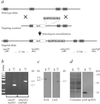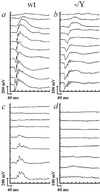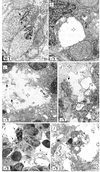Inactivation of the murine X-linked juvenile retinoschisis gene, Rs1h, suggests a role of retinoschisin in retinal cell layer organization and synaptic structure
- PMID: 11983912
- PMCID: PMC122930
- DOI: 10.1073/pnas.092528599
Inactivation of the murine X-linked juvenile retinoschisis gene, Rs1h, suggests a role of retinoschisin in retinal cell layer organization and synaptic structure
Abstract
Deleterious mutations in RS1 encoding retinoschisin are associated with X-linked juvenile retinoschisis (RS), a common form of macular degeneration in males. The disorder is characterized by a negative electroretinogram pattern and by a splitting of the inner retina. To gain further insight into the function of the retinoschisin protein and its role in the cellular pathology of RS, we have generated knockout mice deficient in Rs1h, the murine ortholog of the human RS1 gene. We show that pathologic changes in hemizygous Rs1h(-/Y) male mice are evenly distributed across the retina, apparently contrasting with the macula-dominated features in human. Similar functional anomalies in human and Rs1h(-/Y) mice, however, suggest that both conditions are a disease of the entire retina affecting the organization of the retinal cell layers as well as structural properties of the retinal synapse.
Figures






References
-
- Kellner U, Brummer S, Foerster M H, Wessing A. Arch Clin Exp Ophthalmol. 1990;228:432–437. - PubMed
-
- Puech B, Kostrubiec B, Hache J C, Francois P. J Fr Ophtalmol. 1991;4:153–164. - PubMed
-
- Yanoff M, Kertesz-Rahn E, Zimmerman L E. Arch Ophthalmol. 1968;79:49–53. - PubMed
-
- Manschot W A. Arch Ophthalmol. 1972;88:131–138. - PubMed
Publication types
MeSH terms
Substances
Grants and funding
LinkOut - more resources
Full Text Sources
Other Literature Sources
Molecular Biology Databases
Research Materials

